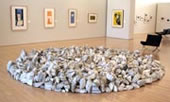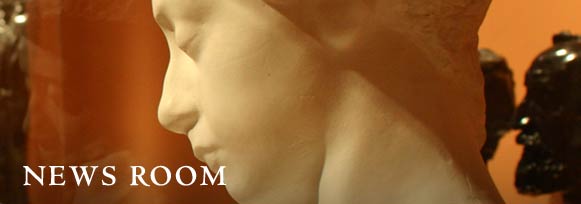Major Sculptures by Contemporary Artists Added to Outdoor Art Collection on Stanford University Campus
Stanford, CA, April 21, 2003—During the months of April and May, significant additions and changes are being made to the outdoor art collection at Stanford University. Thanks to the generous donation of alumnus Toby Schreiber and his wife, Rita, four important works by internationally renowned sculptors will be sited throughout the campus. The pieces include a 29-foot tall steel work by Mark di Suvero; a 16-foot diameter granite circle of stones by British artist Richard Long; a 10-foot tall triad of intertwined triangles by Bay Area artist Charles Ginnever; and a horse by Montana-based sculptor Deborah Butterfield.
Miwok, a sculpture by Mark di Suvero from 1981, is the largest of the four objects. It will be sited in the garden landscaped by Peter Walker and Partners at the Center for Clinical Sciences Research. Weighing approximately 6 tons, Miwok recalls a large totem, as its Native-American title suggests. With elements akin to a head and shoulderblades suspended above a towering leg-like frame, Miwok is more figurative than many of di Suvero's works and complements the abstract sculpture by the artist, The Sieve of Eratosthenes, sited on the north side of the Iris & B. Gerald Cantor Center for Visual Arts at Stanford University.
Richard Long's 1990 Georgia Granite Circle brings to Stanford the first sculpture by this prominent British artist. For three decades, Long has been recognized as one of the founders of the British land art movement. Works such as this stone circle are created when the artist takes journeys on foot during which time he discovers aspects of nature that he reconfigures as art. The sculpture, weighing more than 7 1/2 tons and comprised of several hundred boulder-sized pieces of white Georgia granite, will be installed according to the directions of the artist. With Long's work and Andy Goldworthy's Stone River, which is sited in front of the Cantor Arts Center, Stanford establishes itself as a destination for admirers of contemporary British land art.
The Three Graces, a sculpture in Cor-Ten steel dating from 1975 to 1981 by Charles Ginnever, is his third work of outdoor art to be permanently sited on campus. Like his other two sculptures at Stanford, Luna Moth Walk I and Chicago Triangles, the three 20' x 4' elements comprising The Three Graces are equal in size but are oriented in different ways. The mystery of Ginnever's art lies in understanding this relationship and discovering how light and shadow as well as the viewer's movement in space change the appearance of the three-dimensional sculpture. With Chicago Triangles, which was formerly sited in front of the Schwab Residential Center, The Three Graces will be installed near the Oval in front of the Littlefield Center of the Graduate School of Business. The site for the last of the Schreiber gifts, a reclining horse by Deborah Butterfield made of scrap steel found and welded by the artist, will be determined after the piece is restored.
To vary the locations of works of outdoor art already in the outdoor art collection, several changes will also be made in the next month. Works by Bay Area artists Linda Fleming and Fletcher Benton formerly on view on the Cantor Center's outdoor art terrace will be moved to new sites on the Stanford campus. Fleming's sculpture Space Lace will take up residence on the lawn outside Encina Commons, and Benton's 1987 piece Plate Drawing #12, Phase II will be moved to the courtyard of Sequoia Hall, the location of the Statistics Department.
Another recent addition to the outdoor art collection is three bronze works by Beverly Pepper named the Bedford Sentinels after alumni Peter and Kirsten Bedford who made their fabrication and donation possible. The Bedford Sentinels, sited at the corner of Serra and Galvez Streets next to the Landau Economics Building, compliment Pepper's other work at Stanford, Split Pyramid, on the Cantor Arts Center north lawn. Two large works from 1969 by Tony Smith For D.G. and For J.W. were donated by the artist's estate at the end of 2002. These two sculptures will occupy the site formerly held by Richard Serra's monumental work Call Me Ishmael, which will be returned to the lender this May, after being on view at Stanford for four years.
The siting of these works has been determined by the President's Panel on Outdoor Art. The panel is responsible for the acquisition, siting, and care of the more than 70 sculptures on campus. Cantor Arts Center docents lead free tours of the outdoor art collection on the first and third Sundays of each month at 2 p.m., year round, rain or shine. Outdoor sculpture tours last about one-and-a half hours. First Sunday tours meet at the Main Quad entrance where The Oval meets Serra Street. Third Sunday tours meet in front of the museum.
Visitors can obtain free campus sculpture maps at Cantor Arts Center lobbies and at Stanford's Visitor Information Center in Memorial Auditorium. Call 650-723-3469 for tour information and to arrange group tours.

Richard Long's Georgia Granite Circle, 1990, is now on view in the Cantor Arts Center's McMurtry Family Terrace for contemporary art.



